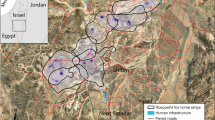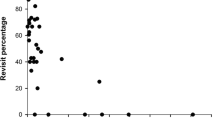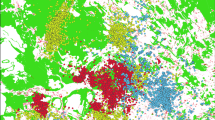Abstract
To meet the need for research on the requirements for corridors for marshland birds, this study set out to quantify gap crossing decisions made by reed warblers moving through the landscape. In three experiments, reed warblers were released into landscape situations with different gap sizes and their movement towards reed patches fringing a watercourse were monitored. In all experiments, most birds flew over the smallest gap towards the nearest reed patch. In the experiment with two gap sizes, the probability of crossing a gap was a function of the ratio between distances to the reed patches. In the experiment with increasing gap sizes, most birds crossed the smaller gaps frequently. Near the bigger gaps, birds did not cross the gaps; instead, they only crossed the watercourse repeatedly. In the third experiment with more realistic landscape configurations, the birds preferred nearby non-reed landscape elements to more distant reed patches. It is concluded that reed warblers were reluctant to cross gaps wider than 50 m. The results suggest that the presence and size of gaps in reed patches affect reed warblers’ local gap-crossing decisions: when given a choice, the birds prefer to cross the smallest gap. Furthermore, reed warblers may be directed towards suitable marshlands by creating corridors of reed vegetation with gaps no wider than 50 m. The surrounding agricultural landscape and the presence of trees and ditches could decrease the reluctance to cross gaps in corridors.
Similar content being viewed by others
References
H.P. Andreassen R.A. Ims O.K. Steinset (1996) ArticleTitleDiscontinuous habitat corridors: effect on male root vole movements J. Appl. Ecol. 33 555–560
P. Beier (1995) ArticleTitleDispersal of juvenile cougars in fragmented habitat J. Wildlife Manage. 59 228–237
P. Beier R.F. Noss (1998) ArticleTitleDo habitat corridors provide connectivity? Review Conserv. Biol. 12 1241–1252 Occurrence Handle10.1046/j.1523-1739.1998.98036.x
M. Bélisle C.C. St. Clair (2001) ArticleTitleCumulative effects of barriers on the movements of forest birds Conserv. Ecol. 5 IssueID2 9
M. Bélisle A. Desrochers M.J. Fortin (2001) ArticleTitleInfluence of forest cover on the movements of forest birds: a homing experiment Ecol. Washington, DC 82 1893–1904
A.F. Bennett (1999) Linkages in the landscape: the role of corridors and connectivity in Wildlife conservation The World Conservation Union (IUCN) Forest Conservation Programme GlandSwitzerland and CambridgeUnited Kingdom
S. Bensch D. Hasselquist (1991) ArticleTitleTerritory infidelity in the polygynous great reed warbler Acrocephalus arundinaceus: the effect of variation in territory attractiveness J. Anim. Ecol. 60 857–871
M. Borowiec (1992) ArticleTitleBreeding ethology and ecology of Reed WarblerAcrocephalus scirpaceus at Milicz, SW Poland Acta Zool. Cracov 35 IssueID2 315–350
D.R. Bowne J.D. Peles G.W. Barret (1999) ArticleTitleEffects of landscape spatial structure on movement patterns of the hispid cotton rat (Sigmodon hispidus) Landscape Ecol. 14 53–65 Occurrence Handle10.1023/A:1008025827895
L. Conradt E.J. Bodsworth T.J. Roper C.D. Thomas (2000) ArticleTitleNon-random dispersal in the butterfly Maniola jurtina: implications for metapopulation models Proc. R. Soc. Lond. B 267 1505–1570 Occurrence Handle10.1098/rspb.2000.1171
T. DenBoer (2000) Beschermingsplan moerasvogels 2000–2004 Rapport directie natuurbeheer nr. 47 Wageningen 183
A. Desrochers S.J. Hannon (1997) ArticleTitleGap crossing decisions by forest songbirds during the post-fledging period Conserv. Biol. 11 1204–1210 Occurrence Handle10.1046/j.1523-1739.1997.96187.x
S. Fischer H. Haupt (1994) ArticleTitleSettling patterns and movements of East-German Great Reed Warblers (Acrocephalus arundinaceus) – an analysis of ringing recoveries of the Hiddensee birdringing station Vogelwarte 37 183–189
R.P.B. Foppen J.P. Chardon W. Liefveld (2000) ArticleTitleUnderstanding the role of sink patches in source-sink metapopulations: reed warblers in an agricultural landscape Conserv. Biol. 14 1881–1892 Occurrence Handle10.1046/j.1523-1739.2000.99022.x
J.-F. Gobeil M.-A. Villard (2002) ArticleTitlePermeability of three boreal forest landscape types to bird movements as determined from experimental translocations Oikos 98 447–458 Occurrence Handle10.1034/j.1600-0706.2002.980309.x
J. Graveland (1998) ArticleTitleReed die-back, water level management and the decline of the Great Reed Warbler (Acrocephalus arundinaceus) in the Netherlands Ardea 86 187–201
P.J. Greenwood P.H. Harvey (1982) ArticleTitleThe natal and breeding dispersal of birds Annu. Rev. Ecol. Systemat. 13 1–21 Occurrence Handle10.1146/annurev.es.13.110182.000245
C.A. Haas (1995) ArticleTitleDispersal and use of corridors by birds in wooded patches on an agricultural landscape Conserv. Biol. 9 845–854 Occurrence Handle10.1046/j.1523-1739.1995.09040845.x
N.M. Haddad (1999) ArticleTitleCorridor and distance effects on interpatch movements: a landscape experiment with butterflies Ecol. Appl. 9 612–622
N. Haddad (2000) ArticleTitleCorridor length and patch colonization by a butterfly, Junonia coenia Conserv. Biol. 14 738–745 Occurrence Handle10.1046/j.1523-1739.2000.99041.x
I. Hanski (1994) ArticleTitleA practical model of metapopulation dynamics J. Anim. Ecol. 63 151–162
S. Harrison A.D. Taylor (1997) Migration within metapopulations, the impact upon local population dynamics Hansi Gilpin (Eds) Metapopulation Biology; Ecology, Genetics, and Evolution Academic Press San Diego
G. Inglis A.J. Underwood (1992) ArticleTitleComments on some designs proposed for experiments on the biological importance of corridors Conserv. Biol. 6 581–586 Occurrence Handle10.1046/j.1523-1739.1992.06040581.x
Leerdam A. van and Vermeer J.G. 1992. Natuur uit het moeras! Naar een duurzame ecologische ontwikkeling in laagveenmoerassen. LNV.
R. Levins (1970) Extinctions Gerstenhaber (Eds) Some Mathematical Questions in Biology. Lectures on Mathematics in the Life Sciences, vol. 2 The American Mathematical Society ProvidenceRI 77–107
S.L. Lima P.A. Zollner (1996) ArticleTitleTowards a behavioral ecology of ecological landscapes Trends Ecol. Evol. 11 131–134 Occurrence Handle10.1016/0169-5347(96)81094-9
MacDonald D.W. and Johnson D.P. 2001. Dispersal in theory and practice consequences for conservation biology. In: Clobert J., Danchin E., Dhondt A.A. and Nichols J.D. (eds), Dispersal. Oxford University Press, pp. 358-372.
C.S. Machtans M.-A. Villard S.J. Hannon (1996) ArticleTitleUse of riparian buffer strips as movement corridors by forest birds Conserv. Biol. 10 1366–1379 Occurrence Handle10.1046/j.1523-1739.1996.10051366.x
I.M. Mansergh D.J. Scotts (1989) ArticleTitleHabitat continuity and social organization of the mountain pygmy-possum restored by tunnel J. Wild. Manage. 53 701–707
M. Mauritzen P.J.M. Bergers H.P. Andreassen H. Bussink R. Barendse (1999) ArticleTitleRoot vole movement patterns: do ditches function as habitat corridors? J. Appl. Ecol. 36 215–222 Occurrence Handle10.1046/j.1365-2664.1999.00414.x
P. McCullagh J.A. Nelder (1989) Generalized Linear Models EditionNumber2 Chapman and Hall London
G. Merriam A. Lanuoue (1990) ArticleTitleCorridor use by small mammals: field measurements for three experimental types of Peromyscus leucopus Landscape Ecol. 4 123–131 Occurrence Handle10.1007/BF00132856
M.L. Morton M.W. Wakamatsu M.E. Pereyra G.A. Morton (1991) ArticleTitlePostfledging dispersal, habitat inprinting and philopatry in a montanemigratory sparrow Ornis Scand. 22 98–106
A.J.V. Noordwijk (1995) ArticleTitleOn bias due to observer distribution in the analysis of data on natal dispersal in birds J. Appl. Stat. 22 683–694 Occurrence Handle10.1080/02664769524540
InstitutionalAuthorNameNPP (1990) Nature Policy Plan. Ministry of AgricultureNature Conservation and Fisheries SDU The Hague (in Dutch)
InstitutionalAuthorNameNPP (2000) Nature Policy Plan: Nature for PeoplePeople for Nature Ministry of AgricultureNature Conservation and Fisheries SDU The Hague (in Dutch)
P. Opdam (1990) Dispersal in fragmented populations: the key to survival R.G.H. Bunce D.C. Howards (Eds) Species Dispersal in Agricultural Habitats Belhaven Press London
P. Opdam (1991) ArticleTitleMetapopulation theory and habitat fragmentation: a review of holarctic breeding bird studies Landscape Ecol. 5 93–106 Occurrence Handle10.1007/BF00124663
P. Opdam R. Foppen C.C. Vos (2002) ArticleTitleBridging the gap between ecology and spatial planning in landscape ecology Landscape Ecol. 16 767–779 Occurrence Handle10.1023/A:1014475908949
Osieck E.R. and Hustings F. 1994. Rode lijst van bedreigde soorten en blauwe lijst van belangrijke soorten in Nederland. Technisch rapport Vogelbescherming Nederland 12. Vogebescherming Nederland, Zeist (in Dutch).
E. Paradis S.R. Baillie W.J. Sutherland R.D. Gregory (1998) ArticleTitlePatterns of natal and breeding dispersal in birds J. Anim. Ecol. 67 518–536 Occurrence Handle10.1046/j.1365-2656.1998.00215.x
J. Pither P.D. Taylor (1998) ArticleTitleAn experimental assessment of landscape connectivity Oikos 83 166–174
M. Ruckelshaus C. Hartway P. Kareiva (1997) ArticleTitleAssessing the data requirements of spatially explicit dispersal models Conserv. Biol. 11 1298–1306 Occurrence Handle10.1046/j.1523-1739.1997.96151.x
B. Rüfenacht R.L. Knight (1995) ArticleTitleInfluences of corridor continuity and width on survival and movement of deermice Peromyscus maniculatus Biol. Conserv. 71 269–274 Occurrence Handle10.1016/0006-3207(94)00036-P
Saunders D.A. and de Rebeira C.P. 1991. Values of corridors to avian populations in a fragmented landscape. In: Saunders D.A. and Hobbs R.J. (eds), Nature Conservation 2: the Role of Corridors.
O.L. Sutcliffe C.D. Thomas (1996) ArticleTitleOpen corridors appear to facilitate dispersal by Ringlet Butterflies (Aphantopus hyperantus) between woodland clearings Conserv. Biol. 10 1359–1365 Occurrence Handle10.1046/j.1523-1739.1996.10051359.x
C.C. Vos (1999) A frog's-eye view of the landscape Wageningen University and DLO Institute for Forestry and Nature Research Wageningen, the Netherlands
C.C. Vos J. Verboom P.F.M. Opdam C.J.F. TerBraak (2001) ArticleTitleTowards ecologically scaled landscape indices Am. Nat. 157 24–41 Occurrence Handle10.1086/317004
Vos C.C., Baveco J.M. and Grashof-Bokdam C. 2002. Corridors and species dispersal. In: Gutzwiller K.J. (eds), In Applications in Landscape Ecology. Springer, pp. 84–104.
L. Wauters P. Casale A. Dhondt (1994) ArticleTitleSpace use and dispersal of red squirrels in fragmented habitats Oikos 69 140–146
J.F. Wegner G. Merriam (1979) ArticleTitleMovements by birds and small mammals between a wood and adjoining farmland habitats J. Appl. Ecol. 16 349–357
G.C. White R.A. Garrot (1990) Analysis of Wildlife Radio-tracking Data Academic Press Inc. San DiegoCA
J.A. Wiens (2001) The landscape context of dispersal J.E. Clobert A.A. Danchin Dhondt J.D. Nichols (Eds) Dispersal Oxford University Press USA 96–109
Author information
Authors and Affiliations
Corresponding author
Rights and permissions
About this article
Cite this article
Bosschieter, L., Goedhart, P. Gap Crossing Decisions by Reed Warblers (Acrocephalus Scirpaceus) in Agricultural Landscapes. Landscape Ecol 20, 455–468 (2005). https://doi.org/10.1007/s10980-004-3168-5
Received:
Accepted:
Issue Date:
DOI: https://doi.org/10.1007/s10980-004-3168-5




